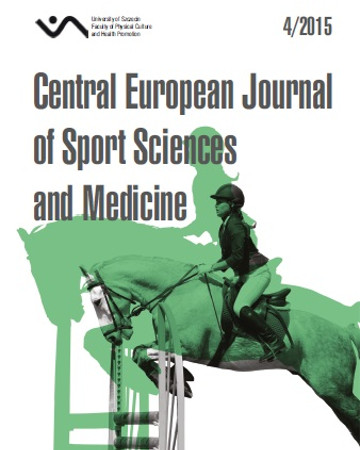
ISSN: 2300-9705
eISSN: 2353-2807
OAI
DOI: 10.18276/cej.2015.4-04




Lista wydań /
Vol. 12, No. 4/2015
The Use of Gross Efficiency Coefficients in Cyclists’ Endurance Tests
| Autorzy: |
Jacek
Borkowski
Department of Physiology and Biochemistry, University School of Physical Education, Wrocław, Poland Rafał Hebisz Department of Physiology and Biochemistry, University School of Physical Education, Wrocław, Poland Daria Sodolska Department of Physiology and Biochemistry, University School of Physical Education, Wrocław, Poland Marek Zatoń Department of Physiology and Biochemistry, University School of Physical Education, Wrocław, Poland |
| Słowa kluczowe: | gross efficiency cycling anaerobic threshold |
| Data publikacji całości: | 2015 |
| Liczba stron: | 6 (36-41) |
Abstrakt
The efficiency of energy conversion of aerobic metabolism to external work is of great importance to sports exercise. Despite this fact, gross efficiency (GE) is not commonly used as a parameter in the assessment of cyclists’ exercise ability. It is also known that road cyclists traverse most of their route at a work intensity below the anaerobic threshold (AT). We tried to examine the relationship between the standard aerobic parameters used for defining the endurance of cyclists and GE, measured just below the anaerobic threshold. Fifty cyclists were subjected to a progressive test. Work done and the basic respiratory and circulatory parameters were measured. Gross efficiency was calculated at work intensity just below AT. We observed a very low correlation (R = –0.137) between GE (24.9 ±2.06) and maximal oxygen uptake (VO2max) – 63.8 ±6,27 ml × kg–1 × min–1. The strongest correlation (R = –0.258) was recorded between GE and the percentage of maximal oxygen consumption (58.9 ±7.0%) for the load prior to the occurrence of the anaerobic threshold. The weak, but existing correlation between GE and selected respiratory and circulatory parameters may suggest that GE provides unique and independent information about the examined athletes.
Pobierz plik
Plik artykułu
Bibliografia
| 1. | Abbiss C.R., Laursen P.B. Models to explain fatigue during prolonged endurance cycling. Sports Med. 2005; 35 (10): 865–898. |
| 2. | Beaver W.L., Wasserman K., Whipp B.J. A new method for detecting anaerobic threshold by gas exchange. J Appl Physiol. 1986; 60: 2020–2027. |
| 3. | Cole M., Coleman D., Hopker J., Wiles J. Improved Gross Efficiency during Long Duration Submaximal Cycling Following a Short-term High Carbohydrate Diet. Int J Sports Med. 2014; 35: 265–269. |
| 4. | de Koning J.J., Noordhof D.A., Uitslag T.P., Galiart R.E, Dodge C., Foster C. An Approach to Estimating Gross Efficiency During High- Intensity Exercise. Int J Sports Physiol Perform. 2013; 8, 682–684. |
| 5. | Dumke C.L., McBride J.M., Nieman D.C., Gowin W.D., Utter A.C., McAnulty S.R. Effect of duration and exogenous carbohydrate on gross efficiency during cycling. J Strength Cond Res. 2007; 21 (4): 1214–1219. |
| 6. | Geasser G., Brooks G. Muscular efficiency during steady-rate exercise: effects of speed and work rate. J. Appl. Physiol. 1975; 38 (6): 1132–1139. |
| 7. | Herman I.P. Physics of the Human Body, Springer, Berlin–Heidelberg–New York 2007. |
| 8. | Hopker J., Coleman D., Passfield L., Wiles J. The effect of training volume and intensity on competitive cyclists’ efficiency. Appl Physiol Nutr Metab. 2010; 35 (1): 17–22. DOI: 10.1139/H09-124. |
| 9. | Hopker J., Coleman D., Jobson S.A., Passfield L. Inverse Relationship between VO2max and Gross Efficiency. Int J Sports Med 2012; 33: 789–794. |
| 10. | Leirdal S., Ettema G. The relationship between cadence, pedalling technique and gross efficiency in cycling. Eur J Appl Physiol 2011; 111: 2885–2893. |
| 11. | McArdle W., Katch F., Katch V. Essentials of Exercise Physiology. Lippincott Williams & Wilkins, 2006. |
| 12. | Moseley L., Achten J., Martin J.C., Jeukendrup A.E. No Differences in Cycling Efficiency Between World-Class and Recreational Cyclist. Int J Sports Med. 2004; 25: 374–379. |
| 13. | Reger M., Peterman J.E., Kram R., Byrnes W.C. Exercise efficiency of low power output cycling. Scand J Med Sci Sports. 2013; 23 (6): 713–721. |
| 14. | Scott Ch.B. Contribution of anaerobic energy expenditure to whole body thermogenesis. Nutr Metab 2005; Jun 15, 2 (1): 14. |
| 15. | Zatoń M., Hebisz R., Hebisz P. Fizjologiczne podstawy treningu w kolarstwie górskim. AWF Wrocław 2011. |